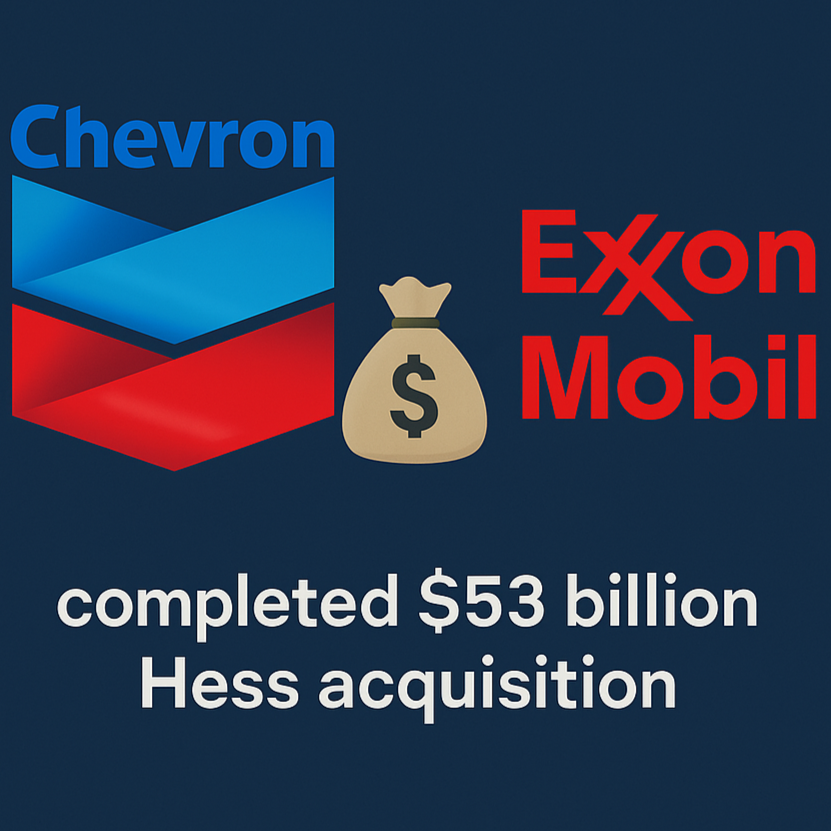The following is an analysis by Claude.ai of the merger approval of Chevron and Hess. The subject matter is far more complex than I’m able to analyze as I’m not a professional investor. I’m only interested in how this affects my holdings as I’m sure you are too. I checked all the links for accuracy.
If you own both Chevron and Exxon stock, here’s how the completed $53 billion Hess acquisition affects your portfolio.
What Happened
Chevron closed its $53 billion all-stock acquisition of Hess Corporation after winning an arbitration dispute with Exxon. The deal gives Chevron access to Hess’s 30% stake in Guyana’s Stabroek oil block, where Exxon operates with a 45% stake and China’s Cnooc holds 25%.
Impact on Your Chevron Holdings
Positives:
- Addresses critical need for production growth beyond 2030
- Adds world-class, low-cost oil reserves in Guyana
- Projects $1 billion in annual cost synergies by 2025
- Brings total output close to 4 million barrels per day
- Should support dividend growth from current 4.47% yield
Negatives:
- $53 billion price tag increases debt and dilutes existing shareholders
- Integration challenges and execution risks ahead
- All-stock structure means CVX shareholders absorb merger risks
- Extended timeline due to arbitration delayed synergy realization
Impact on Your Exxon Holdings
Positives:
- Maintains 45% stake and operational control of Guyana project
- Gains well-capitalized partner with stronger balance sheet than Hess
- Avoids major capital outlay while retaining largest ownership position
- Preserves cash for other investments and shareholder returns
- Benefits from any operational improvements Chevron brings
Negatives:
- Missed opportunity to increase Guyana ownership from 45% to 75%
- Lost potential for greater control over one of world’s most profitable oil projects
- Incurred arbitration costs with no strategic gain
- Chevron now has significant influence in key XOM asset
Operational Considerations
Enhanced Partnership:
- Chevron brings additional capital and deepwater expertise
- Combined resources should accelerate project development
- Both companies incentivized to maximize Guyana’s value
- Elimination of legal disputes allows focus on operations
Project Outlook:
- Current production: 650,000 barrels per day
- Target production: 1.2 million barrels per day by 2027
- Potential for further expansion with stronger partnership
- Low breakeven costs make project highly profitable
Portfolio Implications
Diversification Impact:
- Both holdings now have significant exposure to same Guyana asset
- Reduces geographic diversification in your energy portfolio
- Increases concentration risk in single oil province
- Creates correlated performance based on Guyana success
Financial Metrics:
- Chevron: 4.47% dividend yield, higher debt post-acquisition
- Exxon: 3.7% dividend yield, 42 consecutive years of increases
- Exxon’s debt-to-equity ratio was around 0.15 times while Chevron’s was roughly 0.2 times, both strong positions
- Guyana cash flows should benefit both dividend programs
Key Risks and Opportunities
Shared Risks:
- Guyana political and regulatory changes
- Oil price volatility affecting project economics
- Environmental and operational challenges in offshore drilling
- Potential conflicts between partners despite arbitration resolution
Opportunities:
- Technology sharing and operational best practices
- Economies of scale in logistics and infrastructure
- Faster project development with combined resources
- Higher returns from world-class asset base
What This Means for Your Portfolio
Near-term (1-2 years):
- Chevron faces integration costs and execution challenges
- Exxon continues business as usual in Guyana operations
- Both stocks benefit from reduced legal uncertainty
Medium-term (3-5 years):
- Chevron synergies should materialize and boost returns
- Enhanced Guyana production benefits both companies
- Improved operational efficiency from stronger partnership
Long-term (5+ years):
- Guyana becomes major cash flow generator for both companies
- Sustained production growth supports dividend increases
- Strategic asset provides competitive advantage in global markets
Bottom Line
The Chevron-Hess acquisition creates both opportunities and risks for shareholders of both companies. Your Chevron holdings gain strategic assets needed for long-term growth, while your Exxon holdings maintain operational control with a stronger partner. The key is whether the enhanced Guyana operation generates sufficient returns to justify Chevron’s significant investment and offset the increased concentration risk in your portfolio.

